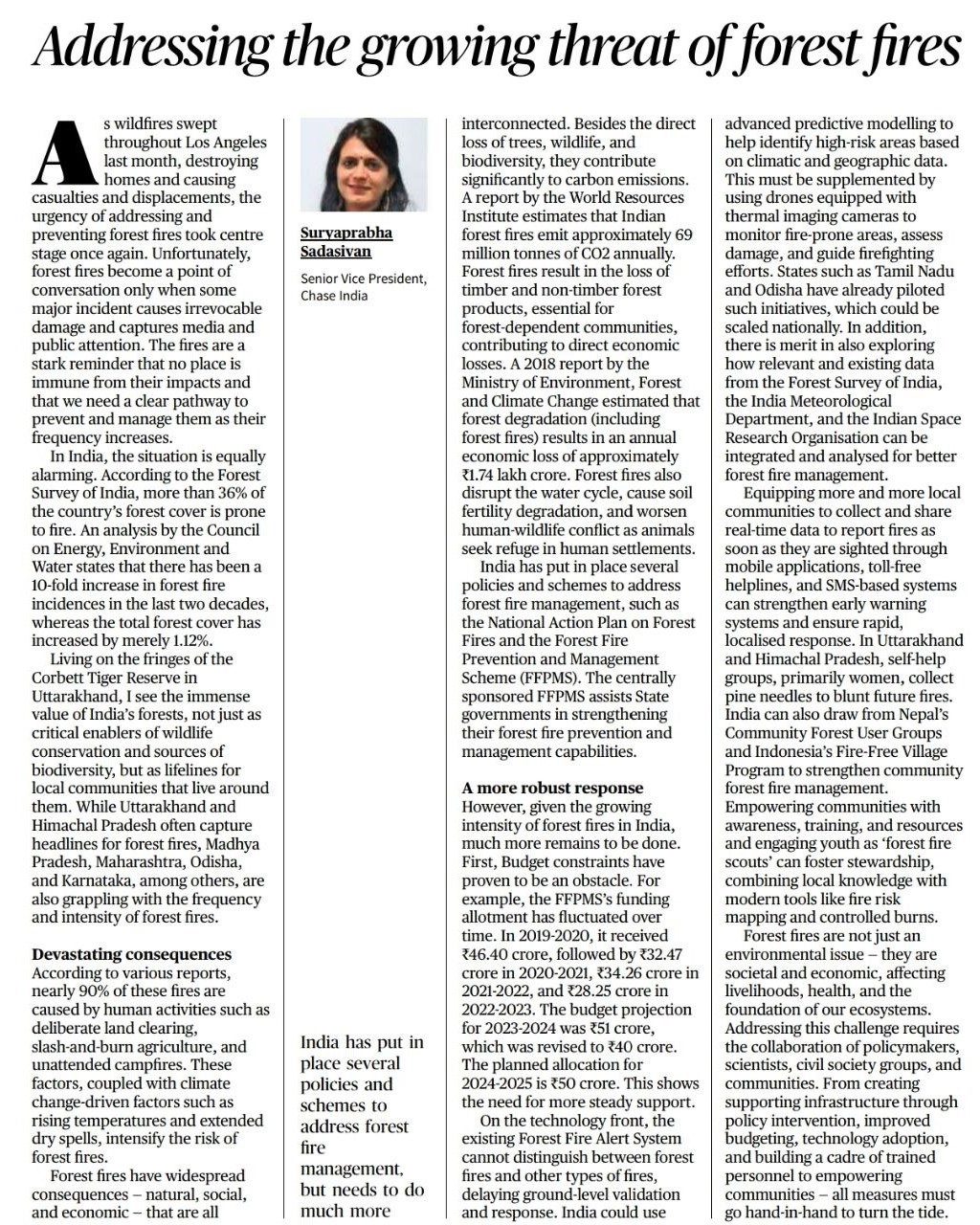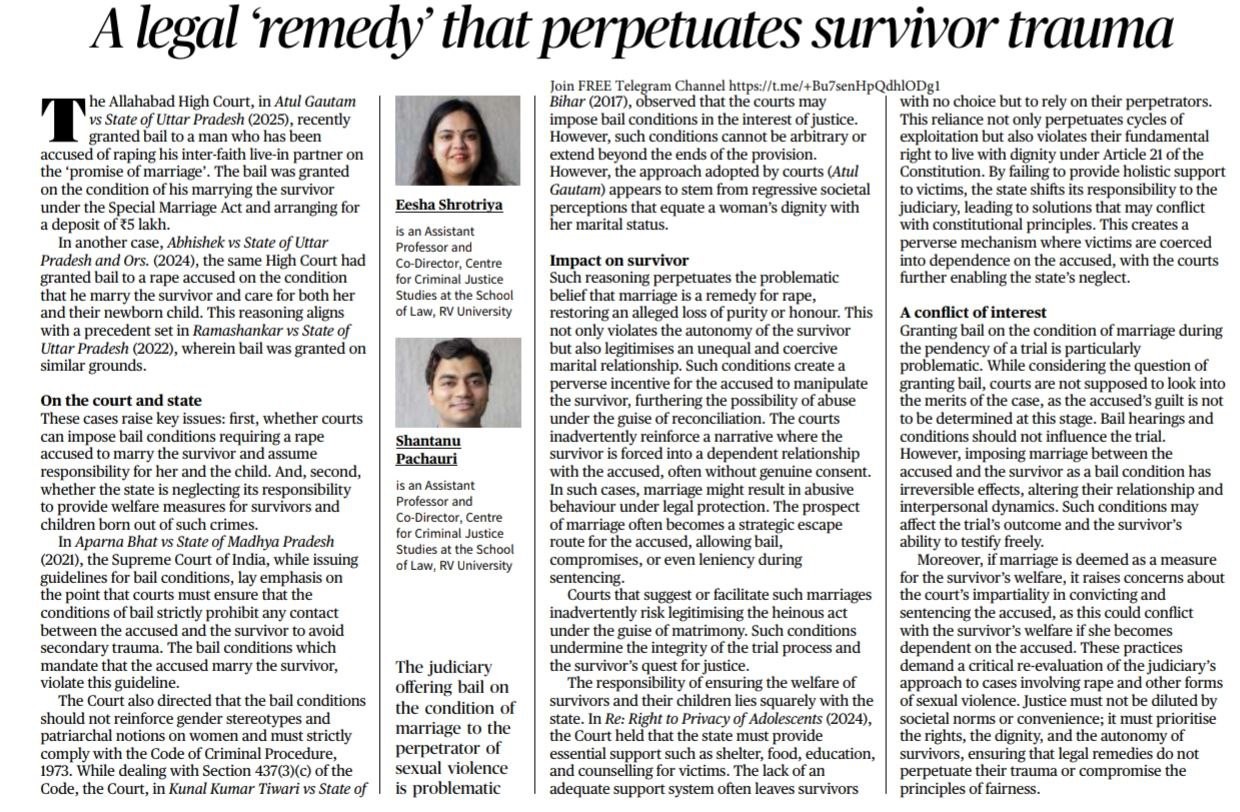1. Tackling the Rising Threat of Forest Fires
Introduction
Forest fires have become an increasing concern globally, with rising incidences due to climate change, human activities, and environmental degradation. India, with its vast forest cover, faces a significant challenge in mitigating and managing these fires. Recent trends show a rise in the frequency and intensity of forest fires, demanding immediate policy interventions and technological advancements
Causes of Forest Fires
- Anthropogenic Factors
- Deliberate land clearing
- Slash-and-burn agriculture
- Unattended campfires
- Natural Factors
- Rising temperatures due to climate change
- Dry spells and prolonged droughts
- Lightning strikes
Consequences of Forest Fires
- Environmental Impact
- Loss of biodiversity
- Increased carbon emissions
- Disruption of the water cycle and soil degradation
- Economic Impact
- Loss of timber and non-timber products
- Damage to forest-dependent communities
- High costs of firefighting measures
- Social Impact
- Displacement of communities
- Increased human-wildlife conflict
- Health hazards due to smoke and air pollution
Government Measures
- National Action Plan on Forest Fires (NAPFF)
- Forest Fire Prevention and Management Scheme (FFPMS)
- Use of Technology
- Advanced predictive modeling
- Drone-based thermal imaging
- SMS-based early warning systems
Challenges in Managing Forest Fires
- Budgetary Constraints – Fluctuations in funding for forest fire management programs.
- Lack of Community Participation – Need for training and awareness programs.
- Inadequate Technology Implementation – Need for real-time data collection and response mechanisms.
Conclusion
Forest fires pose a severe threat to India’s environment, economy, and human well-being. A holistic approach involving technological advancements, policy support, and community engagement is crucial to mitigating the growing risks. Sustainable forest management and proactive measures can ensure long-term resilience against forest fires.
Bottom of FormMains Practice Question |
Q. Forest fires have emerged as a serious environmental and socio-economic challenge in India. Discuss the causes, consequences, and suggest measures to effectively manage forest fires. (250 words) |
2. India’s Role in South-South Climate Cooperation
Introduction
India, as a rapidly growing economy and the third-largest emitter of greenhouse gases (GHG), has a significant role in global climate action. The operationalization of Article 6.2 of the Paris Agreement at COP29 provides an opportunity for India to engage in South-South climate cooperation, leveraging market-based mechanisms to support its transition towards a low-carbon economy.
What is Article 6.2 of the Paris Agreement?
- It facilitates the transfer of Internationally Transferred Mitigation Outcomes (ITMOs) between host and partner countries.
- ITMOs help countries meet their Nationally Determined Contributions (NDCs) by providing flexibility in emissions reductions.
- It supports technology exchange, capacity building, and financial resource mobilization for low-carbon development.
India’s Climate Policies and Readiness for Article 6.2
- India has committed to reducing its emissions intensity by 45% by 2030 and increasing renewable energy capacity.
- Key initiatives include:
- Carbon Trading Mechanism (CTM) 2023 to establish a domestic carbon market.
- National Green Hydrogen Mission and Renewable Energy Expansion for energy transition.
- Voluntary Carbon Market (VCM) and Energy Efficiency Schemes for climate finance.
Opportunities for India in South-South Cooperation
- Unlocking Climate Finance – ITMO transactions can generate financial resources for climate-resilient projects.
- Technology Transfer – Facilitating access to clean energy solutions, particularly in Africa and South Asia.
- Strengthening Bilateral and Regional Partnerships – Collaborating with nations such as South Korea, Japan, and EU countries.
- Job Creation and Green Growth – Expanding renewable energy and sustainable industries.
Challenges in Implementing ITMOs
- Lack of Clear Guidelines – Uncertainty over global rules for carbon trading.
- Market and Data Transparency Issues – Need for robust monitoring and accountability mechanisms.
- Capacity Constraints – Requirement for skill development and institutional capacity building.
- Global Geopolitical Dynamics – Navigating the interests of developed and developing nations.
Conclusion
India has a strategic opportunity to lead the South-South climate cooperation initiative by leveraging Article 6.2 for carbon trading, technology transfer, and climate finance mobilization. Addressing the challenges through robust governance, transparency, and capacity building will be crucial in ensuring equitable and sustainable climate action.
Mains Practice Question |
Q. How can India leverage South-South cooperation to achieve its climate goals under the Paris Agreement? Discuss the potential benefits and challenges of Article 6.2 in this context. (250 words) |
3. Judicial Remedies in Rape Cases: Ensuring Justice for Survivors
Introduction
Recent court rulings in India, such as Atul Gautam vs State of Uttar Pradesh (2025) and Abhishek vs State of Uttar Pradesh (2024), have raised concerns over the judicial practice of granting bail to rape accused on the condition of marrying the survivor. Such rulings highlight the intersection of law, gender justice, and the state’s responsibility toward survivors of sexual violence.
Issues with Granting Bail on the Condition of Marriage
- Violation of Legal Principles
- Goes against Section 437(3)(c) of the Code of Criminal Procedure, which prohibits conditions that create contact between the accused and the survivor.
- Contradicts Supreme Court guidelines (Pawan Bhat vs State of Madhya Pradesh, 2021), which stress that bail conditions should not reinforce gender stereotypes.
- Impact on Survivor
- Legitimizes the problematic notion that marriage is a remedy for rape.
- Forces the survivor into coercive dependence on the accused.
- Can lead to continued abuse under legal protection.
- May allow the accused to escape strict punishment through bail, compromises, or lenient sentencing.
- State Neglect of Survivors’ Rights
- Fails to ensure shelter, food, education, and rehabilitation for survivors.
- Leaves survivors with no choice but to rely on their perpetrators, violating their fundamental rights under Article 21 of the Constitution.
- Conflict of Interest in Judicial Process
- Bail conditions should not influence the trial, as guilt is yet to be determined.
- Marriage between the accused and survivor can alter interpersonal dynamics and impact the survivor’s ability to testify freely.
- Raises questions of judicial impartiality, as leniency may be granted under the pretext of the survivor’s welfare.
Conclusion
Justice for survivors of sexual violence should not be dictated by social norms or convenience. The judiciary must prioritize the dignity, rights, and autonomy of survivors, ensuring that legal remedies do not perpetuate trauma or undermine fairness in the legal process.
Mains Practice Question |
Q. The practice of granting bail to rape accused on the condition of marriage with the survivor raises serious concerns about justice and gender equality. Discuss the implications of such judicial decisions and suggest measures to ensure fair legal remedies for survivors of sexual violence. (250 words) |




